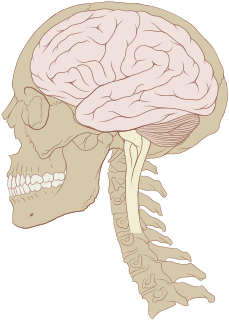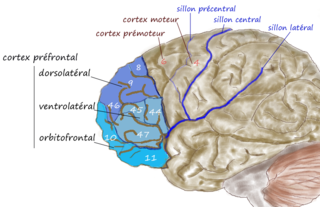Related Research Articles

Psychosis is an abnormal condition of the mind that results in difficulties determining what is real and what is not real. Symptoms may include delusions and hallucinations, among other features. Additional symptoms are incoherent speech and behavior that is inappropriate for a given situation. There may also be sleep problems, social withdrawal, lack of motivation, and difficulties carrying out daily activities. Psychosis can have serious adverse outcomes.

Schizophrenia is a mental disorder characterized by continuous or relapsing episodes of psychosis. Major symptoms include hallucinations, delusions, and disorganized thinking. Other symptoms include social withdrawal, decreased emotional expression, and apathy. Symptoms typically develop gradually, begin during young adulthood, and in many cases never become resolved. There is no objective diagnostic test; diagnosis is based on observed behavior, a history that includes the person's reported experiences, and reports of others familiar with the person. To be diagnosed with schizophrenia, symptoms and functional impairment need to be present for six months (DSM-5) or one month (ICD-11). Many people with schizophrenia have other mental disorders, especially substance use disorders, depressive disorders, anxiety disorders, and obsessive–compulsive disorder.

The limbic system, also known as the paleomammalian cortex, is a set of brain structures located on both sides of the thalamus, immediately beneath the medial temporal lobe of the cerebrum primarily in the forebrain.
Anhedonia is a diverse array of deficits in hedonic function, including reduced motivation or ability to experience pleasure. While earlier definitions emphasized the inability to experience pleasure, anhedonia is currently used by researchers to refer to reduced motivation, reduced anticipatory pleasure (wanting), reduced consummatory pleasure (liking), and deficits in reinforcement learning. In the DSM-5, anhedonia is a component of depressive disorders, substance-related disorders, psychotic disorders, and personality disorders, where it is defined by either a reduced ability to experience pleasure, or a diminished interest in engaging in pleasurable activities. While the ICD-10 does not explicitly mention anhedonia, the depressive symptom analogous to anhedonia as described in the DSM-5 is a loss of interest or pleasure.

The parietal lobe is one of the four major lobes of the cerebral cortex in the brain of mammals. The parietal lobe is positioned above the temporal lobe and behind the frontal lobe and central sulcus.

The frontal lobe is the largest of the four major lobes of the brain in mammals, and is located at the front of each cerebral hemisphere. It is parted from the parietal lobe by a groove between tissues called the central sulcus and from the temporal lobe by a deeper groove called the lateral sulcus. The most anterior rounded part of the frontal lobe is known as the frontal pole, one of the three poles of the cerebrum.

The human brain is the central organ of the human nervous system, and with the spinal cord makes up the central nervous system. The brain consists of the cerebrum, the brainstem and the cerebellum. It controls most of the activities of the body, processing, integrating, and coordinating the information it receives from the sense organs, and making decisions as to the instructions sent to the rest of the body. The brain is contained in, and protected by, the skull bones of the head.

The Institute of Psychiatry, Psychology and Neuroscience (IoPPN) is a research institution dedicated to discovering what causes mental illness and diseases of the brain. In addition, its aim is to help identify new treatments for them and ways to prevent them in the first place. The IoPPN is a faculty of King's College London, England, previously known as the Institute of Psychiatry (IoP).
Peter McGuffin is a psychiatrist and geneticist from Belfast, Northern Ireland.
An auditory hallucination, or paracusia, is a form of hallucination that involves perceiving sounds without auditory stimulus. While experiencing an auditory hallucination, the affected person would hear a sound or sounds which did not come from the natural environment.

The dorsolateral prefrontal cortex is an area in the prefrontal cortex of the primate brain. It is one of the most recently derived parts of the human brain. It undergoes a prolonged period of maturation which lasts until adulthood. The DLPFC is not an anatomical structure, but rather a functional one. It lies in the middle frontal gyrus of humans. In macaque monkeys, it is around the principal sulcus. Other sources consider that DLPFC is attributed anatomically to BA 9 and 46 and BA 8, 9 and 10.
Evolutionary approaches to depression are attempts by evolutionary psychologists to use the theory of evolution to shed light on the problem of mood disorders within the perspective of evolutionary psychiatry. Depression is generally thought of as dysfunction or a mental disorder, but its prevalence does not increase with age the way dementia and other organic dysfunction commonly does. Some researchers have surmised that the disorder may have evolutionary roots, in the same way that others suggest evolutionary contributions to schizophrenia, sickle cell anemia, psychopathy and other disorders. Psychology and psychiatry have not generally embraced evolutionary explanations for behaviors, and the proposed explanations for the evolution of depression remain controversial.
The Prince of Wales International Centre for SANE Research (POWIC) in Oxford houses investigations into finding the causes of and better treatment for serious mental illnesses, such as schizophrenia and depression.
In psychology and neuroscience, executive dysfunction, or executive function deficit, is a disruption to the efficacy of the executive functions, which is a group of cognitive processes that regulate, control, and manage other cognitive processes. Executive dysfunction can refer to both neurocognitive deficits and behavioural symptoms. It is implicated in numerous psychopathologies and mental disorders, as well as short-term and long-term changes in non-clinical executive control.
Childhood schizophrenia is similar in characteristics of schizophrenia that develops at a later age, but has an onset before the age of 13 years, and is more difficult to diagnose. Schizophrenia is characterized by positive symptoms that can include hallucinations, delusions, and disorganized speech; negative symptoms, such as blunted affect and avolition and apathy, and a number of cognitive impairments. Differential diagnosis is problematic since several other neurodevelopmental disorders, including autism spectrum disorder, language disorder, and attention deficit hyperactivity disorder, also have signs and symptoms similar to childhood-onset schizophrenia.
Dichotic listening is a psychological test commonly used to investigate selective attention and the lateralization of brain function within the auditory system. It is used within the fields of cognitive psychology and neuroscience.

Hypofrontality is a state of decreased cerebral blood flow (CBF) in the prefrontal cortex of the brain. Hypofrontality is symptomatic of several neurological medical conditions, such as schizophrenia, attention deficit hyperactivity disorder (ADHD), bipolar disorder, and major depressive disorder. This condition was initially described by Ingvar and Franzén in 1974, through the use of xenon blood flow technique with 32 detectors to image the brains of patients with schizophrenia. This finding was confirmed in subsequent studies using the improved spatial resolution of positron emission tomography with the fluorodeoxyglucose (18F-FDG) tracer. Subsequent neuroimaging work has shown that the decreases in prefrontal CBF are localized to the medial, lateral, and orbital portions of the prefrontal cortex. Hypofrontality is thought to contribute to the negative symptoms of schizophrenia.
Evolutionary psychiatry, also known as Darwinian psychiatry, is a theoretical approach to psychiatry that aims to explain psychiatric disorders in evolutionary terms. A branch of the field of evolutionary medicine, it is distinct from the medical practise of psychiatry in its emphasis on providing scientific explanations rather than treatments for mental disorder. This often concerns questions of ultimate causation. For example, psychiatric genetics may discover genes associated with mental disorders, but evolutionary psychiatry asks why those genes persist in the population. Other core questions in evolutionary psychiatry are why heritable mental disorders are so common how to distinguish mental function and dysfunction, and whether certain forms of suffering conveyed an adaptive advantage. Disorders commonly considered are depression, anxiety, schizophrenia, autism, eating disorders, and others. Key explanatory concepts are of evolutionary mismatch and the fact that evolution is guided by reproductive success rather than health or wellbeing. Rather than providing an alternative account of the cause of mental disorder, evolutionary psychiatry seeks to integrate findings from traditional schools of psychology and psychiatry such as social psychology, behaviourism, biological psychiatry and psychoanalysis into a holistic account related to evolutionary biology. In this sense, it aims to meet the criteria of a Kuhnian paradigm shift.
In psychology, graphorrhea, or graphorrhoea, is a communication disorder expressed by excessive wordiness with minor or sometimes incoherent rambling, specifically in written work. Graphorrhea is most commonly associated with schizophrenia but can also result from several psychiatric and neurological disorders such as aphasia, thalamic lesions, temporal lobe epilepsy and mania. Some ramblings may follow some or all grammatical rules but still leave the reader confused and unsure about what the piece is about.
Schizophrenia is a mental illness characterized by experiencing persistent hallucinations, delusions, paranoia, and thought disorder. These experiences are evident in multiple sensory modalities and include deviation in all facets of thought, cognition, and emotion. Compared to other psychological disorders like major depressive disorder (MDD) and generalized anxiety disorder (GAD), schizophrenia has significantly higher heritability. It has been found to present cross-culturally, and it almost always has 0.1% prevalence in a given population, although some studies have cast doubts on this. Schizophrenia has been hypothesized to be unique to human beings and existing for a long time.
References
- ↑ "New Year's Honours 2018" (PDF). Gov.uk . Government Digital Service. 29 December 2017. p. 26. Retrieved 30 December 2017.
- ↑ Workman and Reader, Lance and Will (2004). Evolutionary psychology: an introduction. Cambridge University Press. p. 330. ISBN 978-0-521-80532-2.
- ↑ Grazi, E. (12 August 2013). "Cerebral ventricular size and cognitive impairment in... [Lancet. 1976] – PubMed – NCBI". The Biochemical Journal. Ncbi.nlm.nih.gov. 151 (1): 167–72. doi:10.1042/bj1510167. PMC 1172339 . PMID 2160.
- ↑ Crow, T J (1997). "Schizophrenia as failure of hemispheric dominance for language" (PDF). Trends in Neurosciences. Elsevier. 20 (8): 339–343. doi:10.1016/s0166-2236(97)01071-0. ISSN 0166-2236. PMID 9246721. S2CID 208787124.
- ↑ McKenna & Oh (2005). Schizophrenic Speech. Cambridge, UK: Cambridge University press.
- ↑ Frith, Christopher (1992). The cognitive neuropsychology of schizophrenia. Psychology Press. pp. 11–12. ISBN 978-0-86377-224-5.
- ↑ Stafford, Tom (2004). Mind Hacks. O' Reilly. ISBN 0-596-00779-5.